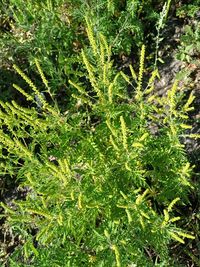Pollen information for Burgenland from 4 September 2025
Exposure to ragweed and reed pollen!
The weather will continue to be summery in the coming days. Only on Friday may there be thundery precipitation in southern Burgenland. Otherwise, sunshine will dominate, so that intense allergic reactions can also be expected.
Ragweed is still the main allergen in the air in Burgenland. For this reason, very high pollen concentrations and the associated stress must also be expected in the coming days. Winds from the south-east are expected on Sunday. This could bring additional ragweed pollen as far as Austria.
If you want to try to avoid ragweedhotspots, you can view a map with all ragweed findings reported by Citizen Scientists in the Ragweed Finder and take this into account when planning leisure activities.
The flowering period of ragweed has passed its first peak. However, late-flowering members of this genus may still produce relevant pollen counts in the coming weeks. Until then, however, only low concentrations of mugwort pollen can be expected in the ambient air.
Only low concentrations of grass pollen are currently being measured at our monitoring centres. However, the grass season is not quite over yet, as the reed blossom is just around the corner. This will lead to a further increase in exposure, particularly around Lake Neusiedl.
The pollen spectrum also includes plantain and stinging nettle. Their pollen can cause additional pollution.
The concentrations of fungal spores currently fluctuate between moderate and high levels. After precipitation, there may be a short-term increase in pollution.
Other types of pollen detected in the ambient air are umbellifers, hemp, hops, balsam, cloves and cypresses. These are of minor allergological significance.
Responsible for the content
AZ Pollenresearch GmbH
im Auftrag der Burgenländischen Landesregierung.
Dr. rer. nat. Johannes M. Bouchal und Lukas Dirr, MSc.
Wetterdaten und Prognosen basierend auf synoptischen Daten:
GeoSphere Austria, Bundesanstalt für Geologie, Geophysik, Klimatologie und Meteorologie (ehemals ZAMG).
zum Team


